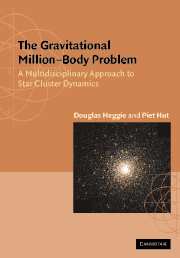Book contents
- Frontmatter
- Contents
- Preface
- PART I INTRODUCTIONS
- PART II THE CONTINUUM LIMIT: N → ∞
- PART III MEAN FIELD DYNAMICS: N = 106
- 10 Violent Relaxation
- 11 Internal Mass Loss
- 12 External Influences
- PART IV MICROPHYSICS: N = 2
- PART V GRAVOTHERMODYNAMICS: N = 106
- PART VI GRAVITATIONAL SCATTERING: N = 3
- PART VII PRIMORDIAL BINARIES: N = 4
- PART VIII POST-COLLAPSE EVOLUTION: N = 106
- PART IX STAR CLUSTER ECOLOGY
- Appendix A A Simple N-Body Integrator
- Appendix B Hints to Solution of Problems
- References
- Index
11 - Internal Mass Loss
Published online by Cambridge University Press: 05 June 2012
- Frontmatter
- Contents
- Preface
- PART I INTRODUCTIONS
- PART II THE CONTINUUM LIMIT: N → ∞
- PART III MEAN FIELD DYNAMICS: N = 106
- 10 Violent Relaxation
- 11 Internal Mass Loss
- 12 External Influences
- PART IV MICROPHYSICS: N = 2
- PART V GRAVOTHERMODYNAMICS: N = 106
- PART VI GRAVITATIONAL SCATTERING: N = 3
- PART VII PRIMORDIAL BINARIES: N = 4
- PART VIII POST-COLLAPSE EVOLUTION: N = 106
- PART IX STAR CLUSTER ECOLOGY
- Appendix A A Simple N-Body Integrator
- Appendix B Hints to Solution of Problems
- References
- Index
Summary
A stellar system in dynamic equilibrium loses neither mass nor energy. In fact the stellar systems in nature do both, and the reasons for this are both external and internal. In this chapter we consider the latter; that is, we consider a stellar system isolated from all external influences, including gravitational ones.
We have two processes in mind. One is caused by the internal evolution of the stars. Note that this is the first occasion on which we have abandoned the point mass model on which we have relied so far, at least to the extent that we now consider time-dependent masses. The other is caused by the gravitational interactions of pairs of stars, which is really the topic of Chapter 14, and will be discussed rather briefly in this chapter. We also deal with the effects in two ways. One is the scaling treatment (Chapter 9) and the other uses a phase space description.
Evolution of length scale
A single star evolves at a rate which is a rapidly increasing function of its initial mass. Therefore, if we examine the stars in an old stellar system, we find that only those with a sufficiently low mass are more-or-less unevolved, with masses close to those they were born with. Those which were born with higher masses will have evolved, and in the process will have lost mass, leaving a remnant which may take the form of a black hole, a neutron star, or a white dwarf. Simple prescriptions for these aspects of stellar evolution have been in use in stellar dynamics for a long time (see Terlevich 1987, Chernoff & Weinberg 1990 and Problem 1).
- Type
- Chapter
- Information
- The Gravitational Million–Body ProblemA Multidisciplinary Approach to Star Cluster Dynamics, pp. 103 - 109Publisher: Cambridge University PressPrint publication year: 2003

